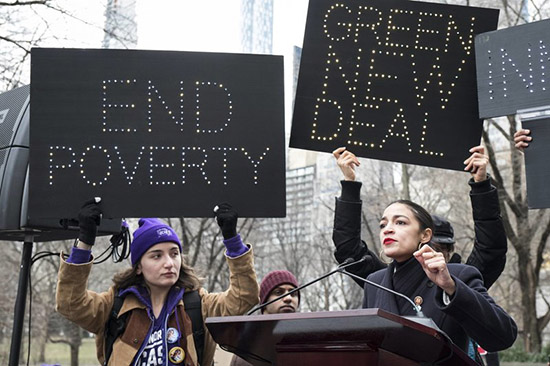
|
绿色新政是自由派的白日梦吗?还是说它能带来一个经济上可行的跨党派气候变化解决方案呢? 来自纽约州的民主党众议员亚历山德里娅·奥卡西奥-科尔特斯及其团队提出的这项方案要让美国改头换面,成为没有碳排放、实现全面就业、经济环境公正平等而且人人都享有正义的国家。和该方案配套的是高额政府支出和美联储的量化宽松,以便实现这些目标。他们觉得既然我们本来就能印钞票,那么成本就是零。 别这么快下结论。虽然赤字性支出和美联储采取刺激措施在经济深度衰退时是好政策,但现在美国已经接近充分就业了。绿色新政要在当下发挥作用,就需要提高税收,以便为所有联邦投资筹集资金。此外,这些投资应该逐步实施。 1960年以来,美国政府基本上一直都有赤字(除了1969年和克林顿的第二个任期)。我们能够一直背负着赤字进行运作的原因是有人把钱借给政府,就像不断地往饼干盒里放饼干一样。主要贷款方是外国(和外国人),他们很想持有大量美元,因为人们普遍认为美元既稳定又耐久。但如果肆意印钱,我们就会受到通胀的困扰,美元稳定的印象将不复存在,也就不会再有人继续往饼干盒里放饼干了。 稳定而缓慢地增加支出可以让我们有更多时间来挑选和评估那些比较有可能奏效的绿色基础设施方案。气候问题不会在5年或者10年内得到解决。我们需要长期保持政府开支的恰当规模。如果政府打造了昂贵的绿色基础设施,大家却更喜欢不那么绿色的行为,那么世界上的所有投资就都解决不了气候变化问题。走这条路就相当于先挖坑,然后再把它们填上。这样做或许能创造大量就业机会,但如果大多数人已经有工作了,新的就业机会就只会把其他生产性活动排挤出去。具体点儿说,我们需要的是这些新工作挤掉那些“脏”工作。就这一点而言,绿色基础设施投资应该向按需型聘用倾斜,而不是简单地向待业者提供工作岗位。 通过提高个人所得税和投资收益税来筹集联邦项目资金可能造成投资和就业下降。在不涉及绿色投资本身的情况下提高整个经济的最低工资水平,辅以更先进的所得税结构能让经济变得更为平等。当然,我们还需要把被忽视的少数族裔社区囊括在内并加以保护。让绿色新政具备公平性和包容性的想法很好,但和旨在直接减少碳排放的举措相比,它们完全或者基本上是另一套政策工具。 最后,我们可以提高成功的可能性,方法是不仅让绿色活动变得更有吸引力,还要让不那么绿色的行为变得不那么有吸引力。这样,绿色新政就得和碳定价搭配。碳定价应该被视为减少温室气体排放的主要元素,而政府对绿色基础设施的聪明投资则是一种有用的补充,不要把二者弄颠倒了。 我的结论是绿色新政有可能奏效,但必须遵循上述三条指导原则,即碳定价、聪明的基础设施投资以及更公平的经济体系。如果这些都在绿色新政里,那就算我一个吧。(财富中文网) 约翰·莱利是麻省理工学院科学和全球变化政策合作项目的联合负责人。 译者:Charlie 审校:夏林 |
Is the Green New Deal (GND) a liberal pipe dream, or is it an opening for an economically viable, bipartisan climate change solution? The program put forward by Rep. Alexandria Ocasio-Cortez (D-N.Y.) and her team reimagines the U.S. as a nation with no carbon emissions, full employment, a fair and equal economy, and justice for all. This GND proposal pairs massive government spending with quantitative easing by the Federal Reserve to achieve these aims. Since we can just print money, the argument goes, it would cost nothing. Not so fast. Whereas deficit spending and a Fed stimulus package are good policies in a deep recession, we are now near full employment. For a Green New Deal to work now, we will need to pay for any federal investment with higher taxes. Moreover, that investment should be rolled out gradually. We’ve been running near constant deficits since 1960 (exceptions being 1969 and the second term of the Clinton presidency). What enables us to run these constant deficits is that someone is lending the government the money, as if continually refilling a cookie jar. The primary lenders are foreign countries (and citizens) eager to hold onto large sums of dollars, a currency widely perceived to be stable and enduring. If we print money with abandon, however, inflation will catch up with us, the perception that U.S. currency is stable will disappear, and the cookie jar will stop refilling. A steady and slow buildup of spending would allow more time to select and evaluate green infrastructure options that have a reasonable chance of working. The climate problem is not going to be solved in five or 10 years. We need the right size of government spending for the long term. If the government builds expensive green infrastructure but people prefer their brown activities, all the investment in the world won’t solve climate change. Taking this path is tantamount to digging holes and filling them in. It may create a lot of jobs, but if most everyone already has a job, the new jobs will just crowd out other productive activities. What’s needed is to have these new jobs crowd out dirty jobs, specifically. Toward that end, green infrastructure investment should favor hiring on the basis of needed workers rather than simply providing job slots for the available workforce. Raising taxes on wages and investment income to fund Federal projects can lead to less investment and employment. A higher minimum wage requirement—unrelated to green investment itself—throughout the entire economy, along with a more progressive income tax structure, can make the economy fairer. Of course, we also need to include and protect neglected minority communities. If we want to bundle equity and inclusiveness into the GND slogan, that’s fine, but they are completely or largely separate policy instruments than those directed toward carbon emission reduction. Finally, we can increase the chance of success by not only making green activities more attractive, but brown activities less so. Thus, the GND needs to be paired with carbon pricing. Carbon pricing should be seen as the main component of reducing greenhouse gas emissions, and smart government investment in green infrastructure as a useful complementary measure, not the other way around. The bottom line is that the Green New Deal could work, but only under the three aforementioned guiding principles: carbon pricing, smart infrastructure investment, and a more just economic system. If all that’s in the GND, then count me in. John Reilly is co-director of the MIT Joint Program on the Science and Policy of Global Change. |






